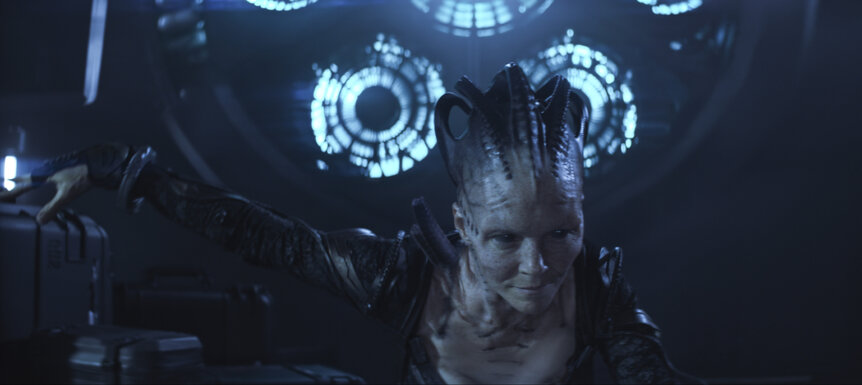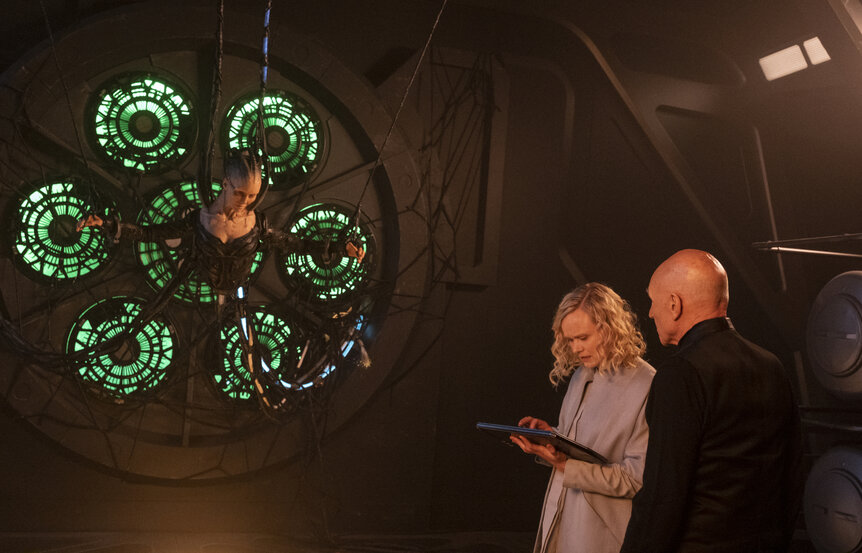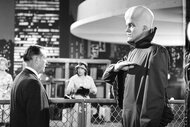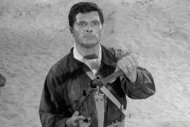Create a free profile to get unlimited access to exclusive videos, sweepstakes, and more!
Star Trek's Terry Matalas answers all our 'Picard' Season 2 questions (so far)
The Picard showrunner unpacks all of Season 2's Deep Space Nine Easter eggs and some storylines we didn't see.
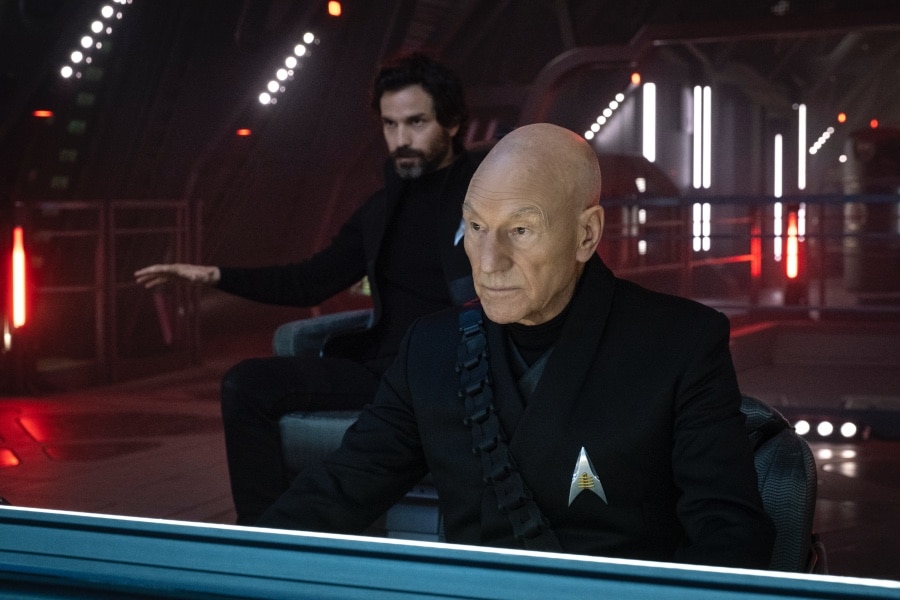
One of Hollywood's biggest Star Trek fans is helping make a Star Trek show. And, so far, four episodes in, it's some of the most entertaining sci-fi that the franchise has done since the days of Sisko and Janeway.
Star Trek: Picard Season 2 showrunner and executive producer Terry Matalas, along with fellow executive producers Akiva Goldsman and Michael Chabon, have both the enviable and daunting task of furthering the adventures of Jean-Luc Picard (Patrick Stewart), and giving fans what they want in a way that they didn't know they needed. Coming off the first season's more cerebral, Star Trek: Blade Runner-esque journey with the former Enterprise captain, where he died and was put in a new synthetic body, Season 2 faced some potentially complicated narrative threads to pick up in the continuation of Picard's emotional journey.
Thankfully, the new season avoids getting too tangled up in where Season 1 left off. Instead, the Paramount+ series puts Picard and his very capable crew on a more "only-Trek-can-pull-off" adventure, one that involves Q (John de Lancie), one alternate reality, the Borg, and (naturally) time travel. The latter of which suits Matalas' sensibilities just fine, as he is the co-creator and former showrunner of SYFY's 12 Monkeys.
As fans can't stop talking about the new season on social media, especially with the appearance of a younger Guinan on this week's fourth episode, which follows an intense and creepy mind heist involving the new Borg Queen (Annie Wersching) in episode three, "Assimilation," SYFY WIRE had an exclusive chat with Matalas about how Season 2 came to be. He takes us on a deep-ish dive into the making of the first three episodes, and discusses what it was like to reach back into key points of Trek's past in an effort to map out its future.
It's a little beat, but who came up with that great, efficient bit of exposition to address Q's age and appearance in Episode 1?
So I came on as they had just finished shooting Season 1, and they had started a little mini-room for Season 2. And that's when I when I came on, I was in a room with Akiva and Michael Chabon and a few others, and I said: "Well, do you guys have any ideas for Season 2?" And obviously, I had a trillion, right? [laughs]. And they said, "No, do you?" And I said: "Well, it's got to be Q. It's one of [Picard's] first relationships." And they were like, "Okay." Immediately, within five minutes, Akiva was like: "Okay, that makes sense. That's probably right for Picard." And then we said something about the aging, and I'm like, "Well, he would just appear how he was, and then Q would say something [to Picard]: 'Oh, I don't want you to feel so bad' and then he'd snap his fingers. So it was just it was just one of those things that sort of easily flowed right from the get go.
Was time travel something that was on the table before you got involved, or was that your idea?
Well, as you know, I have some experience with time travel [laughs]. You know, you always want Star Trek to reflect on the present day. And I had said something like: "Well, you can always do Voyage Home. If there is a reason that makes sense for them to come back in time. And I remember foolishly thinking that [doing a time travel story] would be less expensive and then COVID hit.
I can't imagine shooting a show with this many moving parts during a pandemic. But I am guessing it afforded you and the other writers some time for a 30,000 foot view of things, too.
It was challenging. In some ways, it gave us a little time to sort of re-examine some places we want to go, because there were a lot of ideas that, well, we can't really talk about because you would have to have seen the whole season to know, right? There were some ideas that we abandoned [...] initially, Michael Chabon wrote a two episode version of what was the second episode. Where we really lived in that world for longer and really went into it. For many reasons, we had to move away from that. But there were so many brilliant things that Michael had. The world building into that reality, that was extraordinary. But that sometimes, unfortunately, just ends up on the cutting room floor.
In terms of shifting story around, I talked with Lea Thompson about directing Episode 3, "Assimilation," and she had mentioned that, in the original draft she read, she wasn't set to film any time travel scenes in 203. They were supposed to happen in 202.
Well, I had met with her to direct some episodes of 12 Monkeys, and it was in the show's final seasons, and I think our producing director ended up shooting them. So I wasn't able to hire. But she was always in the back of my mind because, I mean, for obviously Back to the Future reasons and because she is an extraordinarily talented director. So when we had the opportunity, I thought: "Okay, would you be interesting in this?" And I remember her saying that Star Trek, it had always been this thing that eluded her, and she always wanted to be a part of it. I can't remember exactly how her episodes landed, but I believe the time travel aspect was always this part of her second episode that she shot, and we did it in blocks, and it was just this great coincidence.
And the time travel, the means they use is a great callback to Star Trek IV.
The slingshot was for sure. The idea of a Borg Queen executing a slingshot maneuver was high on my list of things I wanted to see.
Speaking of the Queen, the mind heist element of "Assimilation," where Picard helps Jurati (Allison Pill) steal some key info from the Queen's mind... can you talk about how the writer's room approached breaking that storyline?
Well, the challenge is that you're in one room with three people. And it's all after you just had a "run around, shoot 'em up" in an alternate reality. So it's keeping it dramatic and cool for both the fans and for the audiences that aren't aware of how the Borg collective work or and what assimilation might be. So articulating that, as well as doing something new, which is you have Jean-Luc Picard, who is still — even though it's decades later — is fresh off of Locutus. That's not a thing that he's letting go. So watching that happen, it should have the strong, dramatic stakes for a Star Trek fan that you want to see, as well for non-Star Trek fans. So that's that's the trickiest part of it.
And, also, in a scene like that, Allison is extraordinary. She does so much, going into a close-up, those eyes are playing like ten different levels at once. So, when you're lucky enough to have Allison Pill, in a scene like that, you know it's going to work.
The evolution of her character in this season from Season 1, was that a conscious effort? To get her more involved?
Akiva Goldsman is very much my partner, and he was there for all of Season 1, so I think it was more of a natural evolution. You know, the story was set a year away, so we're able to enjoy that character more. Because Jurati had done some hard, and pretty traumatic, things in the first season. So we kind of had to "buy her back," but also stay true to the fact that there is a hole in this character that needs to be filled. And how is she going to fill it?
It seems she is going to have a very unique relationship with the Borg Queen, which is the third version we've seen on Trek. And, when she shows up, the show reprises the Borg theme from Star Trek: First Contact. What was the process in getting Paramount brass to sign off on that?
The music was, that Borg music is just still in my head from sitting in college and watching First Contact on a loop in a theater. So for the music, I just went to my composer, Jeff Russo, and said "I really think we need to use that [cue]. And then, of course, we went to Paramount and they own Star Trek, obviously, so we can figure out all the rights issues there. But it's really just trying to be respectful to Jeff Russo, who could write a brilliant Borg theme on his own. And also, I think we need to nod to what's come before. And he was absolutely game.
And what are the challenges of coming up with a new Borg Queen, and giving a nod to what fans have seen before while also carving out something new for them, too?
As far as redesigning the Borg Queen, we just have a truly brilliant crew over here. Like [Star Trek 2009's] Neville Page, he did the concept art for the character. And then we have James MacKinnon and Vincent Van Dyke who execute the actual prosthetics. So you have three artists, who are at the top of their game, honoring what has come before, but bringing it into the 4K streaming world and, look at what you get it. It's pretty exciting.
Back to Trek IV's influence on the season, I like how Rios plight on Earth in the past is similar to how Chekov's was in Voyage Home. Both are men out of time, detained, and their friends have to go break them out and save them. Was that intentional?
It's one of those things in the writers room where you kind of organically play out things as: "Okay, you have a man out of time, he's without a license, without an I.D., in Los Angeles, and then, you know, getting into some kind of legal trouble. There are these realities that would be in this world, and so that initiates the "what if" part of the [story] process. And, well, we had a lot of versions of that story as well, too. Some were lighter, some were much darker. But, yeah, we debated all that.
What led you to settle on Rios being apprehended by ICE, other than it being a very timely component?
Paramount+, and all of us, we feel very strongly that the story needs to represent everything that's going on today. And how would you view that through the lens of Captain Picard? Through the lens of these people from an elevated society in which they've done away with these prejudices, and how do you shine a light on it through a different perspective? We thought it was important. It was also important to honor what Deep Space Nine had set up, too, in this time period [in the two-parter "Past Tense".]
Speaking of DS9, how cool was it to drop references to Gul Dukat, Martok, Sisko and O'Brien?
It was great. It was never an issue [with Paramount]. I mean, sometimes you might have an exec who's not familiar at all with Trek, but you can say it's from canon and they will accept that. That [this reference] is important to Star Trek fans. To me, it's like, look at how Marvel has integrated their stories into their universe? And I feel that Star Trek should be doing the exact same thing.
New episodes of Star Trek: Picard air Thursdays on Paramount+.
